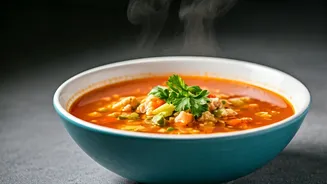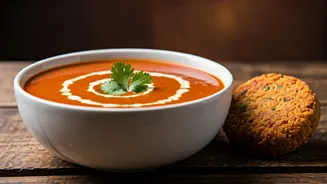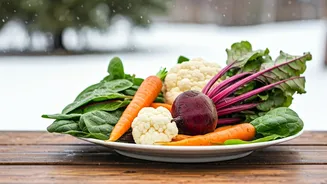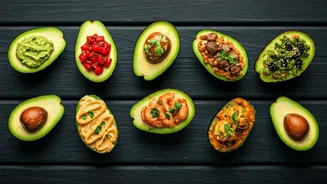Introduction to Nepali Soups
Nepali cuisine, known for its rich flavors and hearty dishes, provides a variety of comforting soups, especially ideal for the winter season. These soups often
combine fresh ingredients, aromatic spices, and a unique preparation style, reflecting the diverse cultural influences present in Nepal. Typically, these soups aren't just meals, but culinary experiences, offering both warmth and a taste of Nepalese culture. Their ability to deliver warmth during the chilly winter months makes them a favorite, embodying the spirit of comfort food with rich tastes and cultural significance. Each soup highlights distinct regional preferences, reflecting the diverse landscapes and traditions of the nation. The use of locally sourced ingredients adds another dimension to the authenticity and cultural significance of these dishes, with local farmers and spice merchants playing crucial roles in the supply chain.
Thukpa: Noodle Delight
Thukpa, a beloved noodle soup, stands out as a staple in Nepali cuisine, particularly in the mountainous regions. The recipe typically involves a broth base, which is infused with the warmth of various spices, setting the stage for a symphony of flavors. Hand-pulled noodles add substance to the soup, usually mixed with fresh vegetables like carrots, spinach, and cabbage, enhancing both flavor and nutritional value. The addition of meat, like chicken or yak, can also be included for a more substantial meal, meeting the diverse tastes of soup lovers. In the snowy terrain, Thukpa not only provides a fulfilling meal but also an energetic boost, which is useful when hiking. Preparing Thukpa at home requires effort, including making fresh noodles and slow-cooking the broth. This effort is well worth the outcome, delivering a flavorful and cozy meal, that reflects the essence of Nepalese culinary traditions.
Gundruk Soup: Fermented Flavors
Gundruk soup, distinctive in its fermentation-based taste, showcases Nepal's aptitude for creating one-of-a-kind flavors. Gundruk, the main ingredient, is a fermented leafy green, typically made from mustard leaves, which gives the soup its unique, tangy taste. The fermentation process adds a specific aroma that is instantly recognizable to anyone acquainted with Nepali cuisine. Beyond gundruk, the soup often includes other vegetables like potatoes and radishes, which deliver additional texture and flavor. The addition of spices such as turmeric, garlic, and ginger enhances the dish's warmth and depth, providing a balance to the fermented flavors. This soup has many health advantages due to its probiotic content from fermentation, which supports healthy digestion. Gundruk soup is an important aspect of Nepali heritage, showing how locals use fermentation to add flavor and nutritional value to their diet.
Sel Roti Soup Fusion
Sel Roti, a traditional ring-shaped rice flour bread, finds a unique application in Nepali cuisine through its integration with soup. Though not a soup in the conventional sense, its combination with a flavorful broth creates a comforting experience. The sel roti is often slightly crispy outside, with a soft interior, providing a texture contrast when submerged in the broth. The broth itself is usually savory, with a base of tomatoes, onions, and various spices, providing a savory undertone. This particular adaptation enables the sel roti to absorb the broth's flavors, ensuring each mouthful is both rich and delicious. This fusion of elements represents the ingenuity of Nepali cooks who have found innovative ways to present traditional ingredients. The blending of the crunchy sel roti and the flavorful soup is more than just a dish; it's a testament to the creativity of Nepali food and its constant evolution.
Tomato Soup: Simple Comfort
Tomato soup, a staple across many cultures, also features in Nepali cuisine. It delivers a simple yet satisfying taste that warms and comforts. The Nepali version typically begins with fresh tomatoes, which are cooked to release their natural sweetness and create a smooth base. Onions, garlic, and sometimes chili are added for flavor and warmth. These ingredients enhance the tomato's natural taste, resulting in a rich and well-balanced broth. The simplicity of tomato soup doesn't mean it lacks flavor; the careful preparation and selection of ingredients are crucial. This soup is a straightforward meal that captures the essence of Nepali cooking: fresh ingredients, simple techniques, and a focus on natural flavors. It is an excellent example of how Nepali cuisine adapts traditional recipes, making them their own through local ingredients and cooking techniques.
Dal Soup: Lentil Delight
Dal soup, a core component of Nepalese cuisine, is a hearty lentil-based dish. The foundation of this soup is lentils, a vital source of protein and nutrition. These lentils are cooked with water and spices until they reach a smooth and creamy consistency. The addition of aromatic spices like cumin, coriander, and turmeric provides depth and warmth, enriching the dish's flavor. The result is a filling and flavorful soup that is suitable for any season, but especially delightful during colder months. Dal soup reflects Nepali culinary traditions, and is commonly served with rice or roti. It is a symbol of nourishment and a staple in many Nepali homes, showcasing the versatility and value of lentils in Nepalese cuisine. Its preparation and the ingredients involved speak volumes about the Nepalese people's resourcefulness and their ability to produce delicious, nourishing food.














